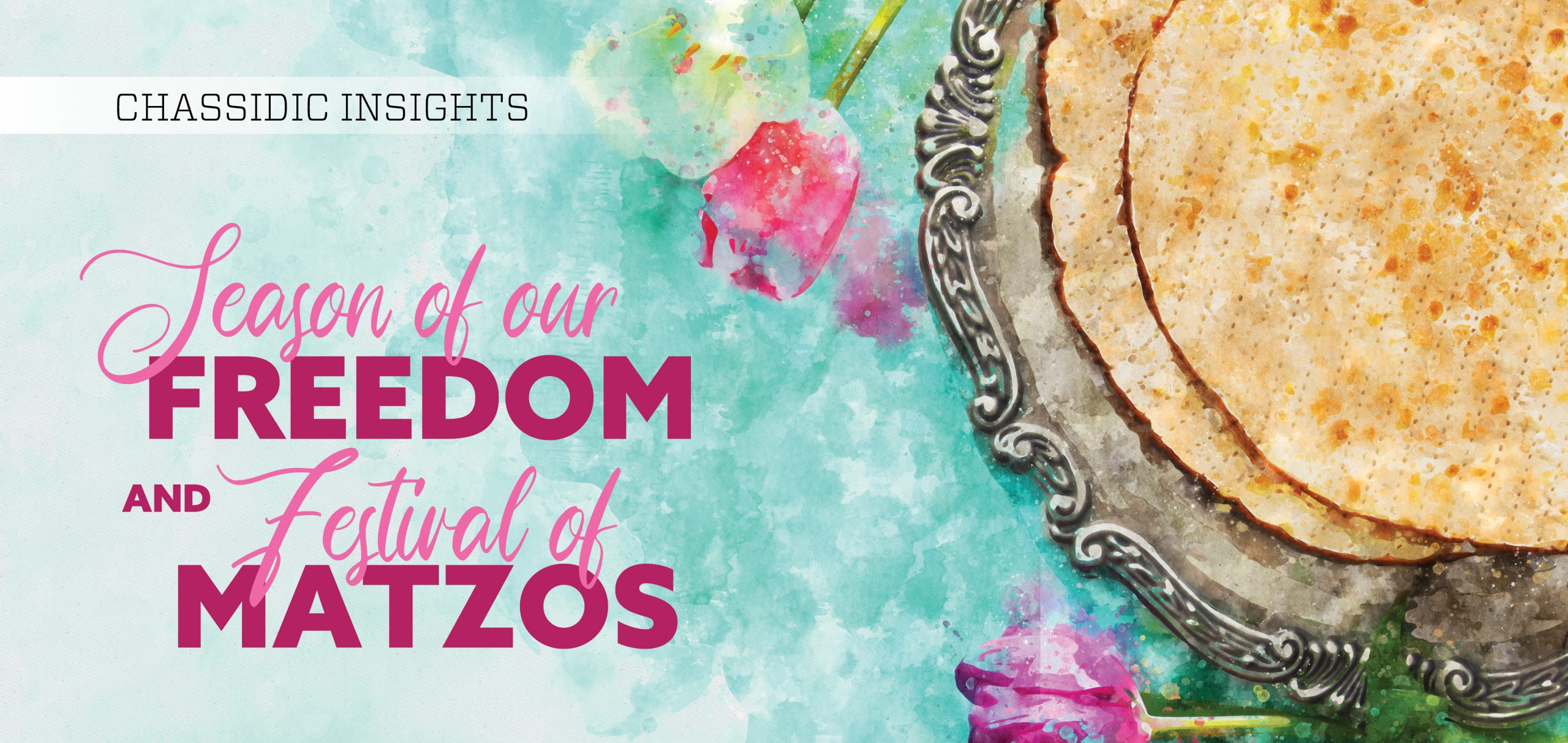Based on the teachings of the Lubavitcher Rebbe, Rabbi Menachem M. Schneerson
The festival of Passover is commonly referred to in our prayers as the “Season of our Freedom” [זמן חרותינו] and the “Festival of Matzos” [חג המצות]. These names relate to aspects of Passover that are germane at all times and in all places.
The other names of this holiday — “Passover” [פסח] and the “springtime festival” [חג האביב] — apply only to distinct times and places: The name “Passover” is related to the Passover offering, which could be brought only when the Holy Temple stood; “springtime festival” refers only to the Northern Hemisphere, for in the Southern Hemisphere Pesach occurs in the fall.
Understandably, the festival’s message for the entire year1 can best be leaned from those titles that apply at all times and in all places. The term “Season of our Freedom” alludes to more than just the Jews’ freedom from enslavement in Egypt thousands of years ago: it invokes the true freedom of each and every Jew in all times and places.
The ultimate purpose of the Exodus finds expression in the verse:2 “Upon your taking out the nation from Egypt they shall serve Hashem on this mountain,” i.e., the experience of receiving the Torah at Sinai. For the Jewish people could not be truly free of the physical bondage of Egypt until they were spiritually free as well.3
Spiritual enslavement — the Hebrew word for Egypt being etymologically related to “straits and limitations”4 — can come about from without as well as from within [מצרים וגבולים]: A person may be enslaved to the mores of his society, or he may be a slave to his own passions. True freedom from this kind of enslavement can be achieved only through Torah and mitzvos — “serving Hashem on this mountain.”
But what specifically is the freedom seeker to do? Herein comes the lesson of the festival’s other name — the “Festival of Matzos.”
The “Festival of Matzos” consists of two parts: the obligation to eat matzah and the prohibition of eating chametz, leavened products. The obligation to eat matzah is limited to a specific amount at a specified time — a quantity the size of an olive must be eaten on the first night of Passover.5 However, the prohibition against chametz knows different limits; the tiniest particle of chametz is forbidden throughout the holiday.6
The natural differences between chametz and matzah, and the consequent differences between eating matzah and refraining from chametz provide a valuable lesson in the quest for spiritual freedom.7
Leavened dough rises continually. Matzah is the very antithesis thereof — the dough is not permitted to rise at all.
Our Rabbis explain8 that chametz is symbolic of haughtiness and conceit — traits so deleterious that they are at the root of all negative traits. This is one of the reasons why even the minutest amount of chametz is forbidden —
haughtiness and conceit must be completely nullified.9
Ridding oneself of the traits represented by chametz and performing the mitzvah of eating matzah enable the Jew to overcome his own faults and the blandishments of the mundane world. He is then able to free himself from spiritual exile, and enjoy this freedom throughout the year.
Based on Likkutei Sichos Vol. XXII pp. 266-270.
The content in this page is produced by Chabad.org, and is copyrighted by the author and/or Chabad.org. If you enjoyed this article, we encourage you to distribute it further, provided that you do not revise any part of it, and you include this note, credit the author, and link to www.chabad.org. If you wish to republish this article in a periodical, book, or website, please email [email protected].
- See Likkutei Torah, Berachah 98b.
- Shmos 3:12.
- See Avos 6:2; See also Shmos Rabbah 41:7; Vayikra
Rabbah 18:3; Zohar II 113b and onward. - See Torah Or, Yisro 71c and onward.
- Tur and Shulchan Aruch and Shulchan Aruch Admur HaZakein, Orach
Chayim 475. [The size of one “olive” in Halachah is 28 grams, or 1 ounce.] - Pesachim 30a; Rambam, Hilchos Chametz u’Matzah 1:5; Tur and Shulchan
Aruch and Shulchan Aruch Admur HaZakein, Orach
Chayim beginning of section 447; Shulchan Aruch Admur HaZakein,
Orach Chayim beginning of sections 431 and 445. - See Likkutei Torah, Tzav first ma’amar titled Sheishes Yamim ,
ch. 3; Likkutei Torah, Shir HaShirim 14d and onward, et al. - See places cited in previous footnote.
- See Rambam, Hilchos Deos 4:3; commentary of R. Yonah on Avos 4:4.


 EN
EN  ZH
ZH  KR
KR  BR
BR  ES
ES  IN
IN  IL
IL 




